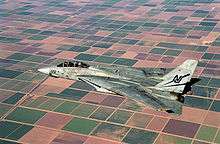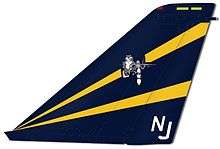VF-124
| Fighter Squadron 124 | |
|---|---|
|
VF-124 squadron patch | |
| Active | August 16, 1948 - September 30, 1994 |
| Country | United States |
| Branch | United States Navy |
| Type | Fleet replacement squadron |
| Part of | Inactive |
| Nickname(s) | "Gunfighters" |
| Engagements | Korean War |
| Aircraft flown | |
| Fighter |
F4U-4B Corsair F9F-5 Panther F-8 Crusader F-14 Tomcat |
Fighter Squadron 124 or VF-124 Gunfighters was a fleet replacement squadron of the United States Navy. Originally established on 16 August 1948 as VF-53 it was redesignated VF-124 at NAS Moffett Field on 11 April 1958 due to a need for an increased number of flight training squadrons, itself necessary because of introduction of swept wing fighters into Navy service. The squadron's task was the training of pilots for the F-8 Crusader and later the F-14 Tomcat. The squadron was disestablished on 30 September 1994.[1]
History
Korean War
VF-53 equipped with F4U-4B Corsairs was assigned to Carrier Air Group 5 aboard USS Valley Forge from 1 May to 1 December 1950 and was one of the first navy squadrons deployed to the Korean War. The squadron deployed again on USS Essex from 26 June 1951 to 25 March 1952. Reequipped with the F9F-5 Panther the squadron deployed on USS Valley Forge from 20 November 1952 to 25 June 1953.[2]
Training squadron
VF-124 had four missions assigned. One was fleet readiness evaluation in the early 1950s of the F7U-3 Cutlass. VF-124 was assigned to go aboard the USS Hancock to test the British steam catapult system and then deployed on a Pacific cruise to Japan. The F7U was deemed to be unsatisfactory for fleet use and was stricken from Naval Air inventory in 1955.
VF-124 was used to do initial training of F-8 Crusader pilots, bringing them to a standard where they were ready to join a fleet squadron, refresher training for aviators returning to the Pacific Fleet, and also providing maintenance training for ground personnel on the F-8.


This last mission is often overlooked, but was a crucial part of the training provided by a Fleet Readiness Squadron. In addition to these training roles, VF-124 maintained its instructor crews as combat ready pilots in case of national emergency. Flying the F8U-1, TV-2 and F9F-8T the Gunfighters won the Safety S awards for 1958 and 1959.
After three years at Moffett Field VF-124 moved to Naval Air Station Miramar. By 1970 VF-124 became the Pacific Fleet training squadron for the new F-14A Tomcat. VF-124 stopped training F-8 pilots in August 1972 and responsibility for the small number of F-8s left was handed over to VFP-63. VF-124 received their first F-14As on October 8, 1972. A few days later the two first active fleet F-14A squadrons, VF-1 and VF-2 were commissioned. In December 1973, US Marine Corps officers reported to VF-124 to start training as instructors. USMC involvement continued until 1976 when it was decided that the F-14 was too expensive for the USMC to operate. The first set of replacements pilots trained by VF-124 took to sea in December 1974, flying day and night carrier qualifications of the deck of USS Kitty Hawk.



In 1976 personnel from the Imperial Iranian Air Force arrived to begin training on the F-14 until the overthrow of the Shah three years later. As a new decade began the role of reconnaissance was introduced to the F-14 with the TARPS pod. VF-124 began to teach air and ground crews how to operate the pod. By December 1988 VF-124 had trained 1502 aircrew, over 14,400 maintenance personnel and flown over 153,193 flight hours and VF-124 also achieved 124 days without any Foreign Object Damage.
With the introduction of the improved F-14D Super Tomcat, VF-124 was assigned the role of training air and ground personnel on the new aircraft and the first F-14D was accepted on November 16, 1990, with four aircraft undertaking the first fleet F-14D carrier qualifications on board USS Nimitz on October 2, 1991.
On March 11, 1993 a VF-124 F-14 made the final landing on USS Ranger, Lieutenant Mark A. Garcia and Lieutenant Tim Taylor completed the carrier’s 330,683rd landing. With the downsizing of the F-14 squadrons in the early 1990s the Navy’s training squadrons were reduced and VF-124 was disestablished in September 1994 and the responsibility of all F-14 training went to VF-101. VF-124 would operate the F-14A Tomcat and the F-14D Super Tomcat as all F-14B Tomcats were flown by the Atlantic Fleet Squadrons.
See also
- History of the United States Navy
- List of inactive United States Navy aircraft squadrons
- List of United States Navy aircraft squadrons
References
- ↑ "Fighter Squadron Lineage". Naval History and Heritage Command. Retrieved 6 October 2016.
- ↑ "Carrier, Carrier based Squadrons and non-Carrier based Squadron deployments during the Korean War" (PDF). Naval History and Heritage Command. Retrieved 1 March 2016.

